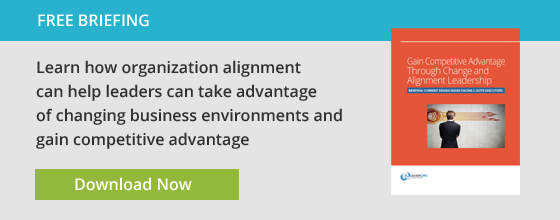There is a tendency among organizations to equate strategy with goal setting: what we want to become, where we want to go, what we want to achieve. These goals are often set from a financial or operational performance perspective. For example, targeting revenue goals, achieving a market leadership position, or increasing sales of a new product. Goals of this type are, of course, an important part of strategy, because they help define where the organization is headed and what it needs to be capable of delivering. However, goal setting alone is not sufficient to ensure success.
In addition to setting objectives, it is also important to consider the connection between an organization’s goals and how it is set up (how it is designed) to deliver the strategy. Let’s look at two dimensions of strategy that affect organization design.
Taking Goal Setting to the Next Level Through Organization Design
One aspect of strategy to is take your strategic goals and objectives and define the outcomes you hope to achieve by accomplishing your goals and objectives. These outcomes might include things like the scale, speed, and/or volume of work accomplished, the number of markets you want to enter, etc. It is sometimes necessary to drive strategic thinking down to the outcomes sought so that you know what capabilities and capacity the organization must have to accomplish strategic goals or objectives.
This subject came up in a conversation last week with a colleague who is president of a small retail business. The company had recently undergone a period of rapid growth. They had achieved quite a few of their goals, but despite this, the organization was showing signs of decline. Like a skier whose momentum has outpaced himself, they were not able to keep up with their own velocity and found themselves tumbling rapidly downhill. My colleague had to take a step back to help his organization build and strengthen the structures, roles, work processes, partnerships, and metrics of the organization—all the things that are needed to sustain execution, speed, and growth. He even admitted, “I’ve slowed down our growth so we can catch up.”
Designing for Differentiation
The second aspect relates to differentiation. The question: “why should someone choose us over someone else?” has a lot of impact on how you set up your organization. If you want someone to choose you for highest quality products, for instance, you have to design an organization that can deliver the highest quality products.
Years ago, I worked with a manufacturer of cleaning products that was a leader in their industry. In addition to their own brands, they manufactured white-label products for other companies. One of their biggest customers was putting a lot of pressure on my client regarding quality, saying they were getting too many returns. One of the people I worked with confided in me, “We don’t even have machines that can make products at the level of quality being asked of us. The tolerances our machines are capable of are not precise enough.” This company had found itself in the position of being asked to win on a point of differentiation they were not set up to deliver.
One response to being in this position might be to differentiate oneself on something other than quality. This may be a valid response in some cases. However, regardless of what you choose to compete on, someone else may come along who can outshine you. Part of your strategy needs to include finding ways to deliver on your promise and maintain your chosen position in the market.
Putting Your Organization Design Strategy Into Action
Of course, it is one thing to identify where your organization needs to set itself up strategically and another to do it in a way that aligns throughout the organization. Here is where our Cube model of organization design proves its value. Decisions made around both goal setting and differentiation have to inform all six organization systems in a company: work processes, structure and governance, information and metrics, people and rewards, continuous improvement, and culture and leadership. By understanding the trickle-down effect of one’s strategic decisions on all sides of the organizational Rubik’s Cube, you can create goals and make organization design decisions that are not only achievable but also sustainable, as well as ensure that your organization can deliver on its goals and objectives.

